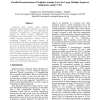Free Online Productivity Tools
i2Speak
i2Symbol
i2OCR
iTex2Img
iWeb2Print
iWeb2Shot
i2Type
iPdf2Split
iPdf2Merge
i2Bopomofo
i2Arabic
i2Style
i2Image
i2PDF
iLatex2Rtf
Sci2ools
100
Voted
IPPS
2009
IEEE
2009
IEEE
Parallel reconstruction of neighbor-joining trees for large multiple sequence alignments using CUDA
Computing large multiple protein sequence alignments using progressive alignment tools such as ClustalW requires several hours on state-of-the-art workstations. ClustalW uses a three-stage processing pipeline: (i) pairwise distance computation; (ii) phylogenetic tree reconstruction; and (iii) progressive multiple alignment computation. Previous work on accelerating ClustalW was mainly focused on parallelizing the first stage and achieved good speedups for a few hundred input sequences. However, if the input size grows to several thousand sequences, the second stage can dominate the overall runtime. In this paper, we present a new approach to accelerating this second stage using graphics processing units (GPUs). In order to derive an efficient mapping onto the GPU architecture, we present a parallelization of the neighbor-joining tree reconstruction algorithm using CUDA. Our experimental results show speedups of over 26× for large datasets compared to the sequential implementation.
ClustalW | Distributed And Parallel Computing | IPPS 2009 | Progressive Multiple Alignment | Tree Reconstruction |
| Added | 24 May 2010 |
| Updated | 24 May 2010 |
| Type | Conference |
| Year | 2009 |
| Where | IPPS |
| Authors | Yongchao Liu, Bertil Schmidt, Douglas L. Maskell |
Comments (0)

